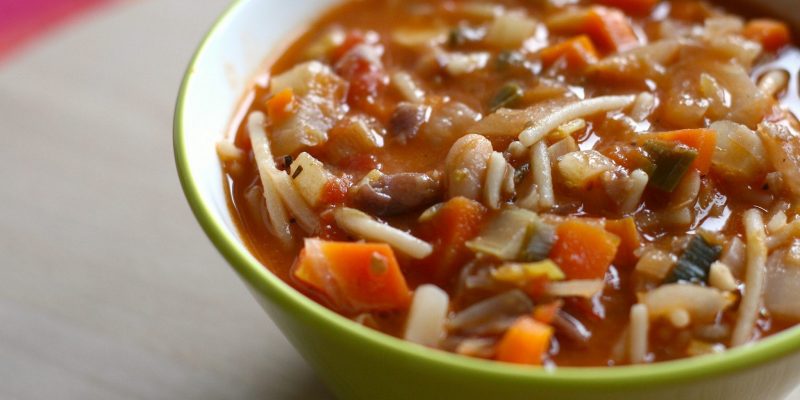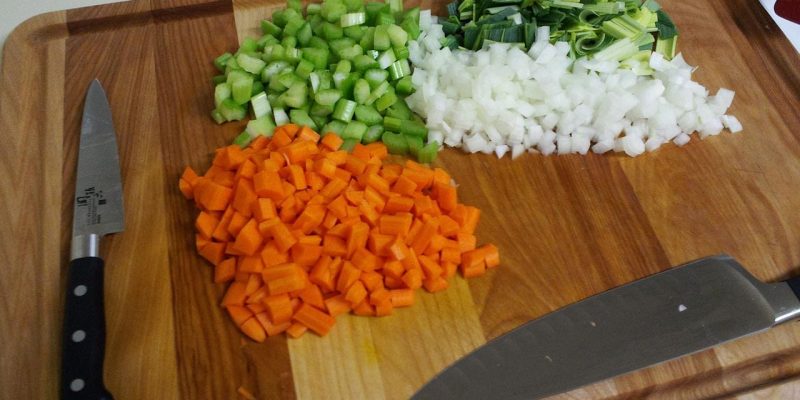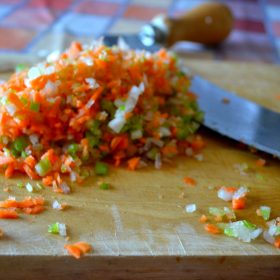It’s a fact that there have been a surge of health-conscious cooking in the culinary world lately.
And with the emergence of so many troubling medical conditions, it’s no wonder that more and more people have become cautious about what they eat.
But do you know that in traditional Italian cooking, the use of healthy ingredients, especially fresh vegetables and herbs, have more or less been a staple for many dishes? Case in point, the savory Italian base to many traditional dishes: soffritto.
Based on the Italian verb soffriggere, which means “to stir fry” or “saute,” soffritto is more of a cooking technique rather than a traditional dish in itself.
It is essentially a base that consists of minced vegetables, which are sautéed in olive oil or butter until the ingredients’ rich flavors come out and are ready to mix, mingle, and party with your main dish… so to speak.
It is among the most popular base for all kinds of traditional Italian dishes but is typically associated with the Tuscany region.
Now, the most basic soffritto is called, by some, as “holy trinity” because it basically only calls for onions, carrots, and celery. First you do is chop the three ingredients into tiny cubes, or mince them, whichever you prefer.
Then sauté them in butter or olive oil for at least 5 minutes, or until they turn golden brown. Ecco, you have soffritto! Quite simple really.
However, if you want to draw out all kinds of delectable flavor from this quintessential Italian base, you may add a couple or more of other vegetables, herbs, and spices, even cold meats such as prosciutto.
Once done, you can use it as a base to all sorts of Italian dishes such as sauces like arrabbiata, soups such as minestrone, stews, and risotto dishes. But of course, you are absolutely free to do with it what you want.

Much like many of Italy’s traditional dishes, it has several different versions throughout the Italian peninsula. In fact, it has counterparts in other countries as well, many of which will be discussed later on.
Versions of this simple but very flavorful base can also be found in other parts of the world, besides bella Italia. In which corners of the world in particular? Well, read some of them below:
Considered the French counterpart of soffritto, mirepoix is basically diced vegetables sautéed in butter under low heat for an extended length of time.
The purpose of this is to coax the sweetness from the vegetables rather than actually sautéing them.
In other words, it is much like soffritto except that your goal is not to turn the vegetables golden or caramelized.
They can be diced or minced, depending on the dish they’re going to be used in. And usually, it also includes some tomato paste that lends it a dark brown color when done.

The Spanish cousin of Soffritto, which is kind of obvious due to the only slight differences in spelling, the word literally translates “to lightly fry something.”
Now, sofrito is a technique in Spanish cooking that originally came from the Catalan region but has now spread to the entire country, as well as its former colonies such as in the Caribbean and Latin America.
It is particularly popular in the Dominican Republic and Puerto Rico, where it is called sazón and recaito respectively.
According to historians, centuries ago, sofrito called for sautéed onion or leeks (or both), with bacon or any salted pork.
As centuries passed, many herbs, spices, and vegetables have been added to the recipe. Today, the typical basic sofrito has garlic, onions, olive oil, paprika, peppers, and tomatoes.
From the Catalan word sofrefir, which means “to underfry,” sofregit is a Spanish cooking technique that had its first ever mention in one of the oldest cookbooks in the world, the Libre de Sent Soví, which was published in 1324.
Today, it is basically a mixture of garlic, onions, olive oil, tomatoes, and sometimes also peppers and mushroom. The ingredients are sautéed from 15 minutes to about half an hour or so, in low heat.
Yep, these two also belong in Italian cuisine, and are sort of like soffritto in a sense. Battuto typically has cold meats in it such as pancetta or salted pork while trito only has the vegetables.
And the main difference between soffritto and battuto or trito is that the latter are what you call the raw minced vegetables you need to make soffritto. Simply put, battuto or trito is sautéed in butter or olive oil and becomes soffritto.
Note: Many sticklers for convention insist that in order to make authentic battuto, you have to use a mezzaluna (a single or double curved blade with two handles).
However, many chefs have said that any sharp knife would be able to do the job just as well. But then, if you already have one, probably one handed down from your nonna, then you’re in luck.

Considered the Portuguese soffritto, its typical ingredients are garlic, onion, saffron, and smoke paprika. Some also add an array of herbs and spices to mixture. And much like soffritto, its ingredients are sautéed in olive oil and is approximately cooked for 15 to 30 minutes.
The name literally means “soup greens” in English. It is a technique in German cooking that typically requires carrots, celery root, leeks, and usually also with a dash parsley. And depending on the region, some may also include onions, rutabaga, and/or thyme.
A Polish version of soffritto, its name literally means “Italian stuff” and is a mixture of carrots, celery, leek, and parsley. Unlike soffritto, however, this version may also include white or savoy cabbage in it.
Much like soffritto, and as its name suggests, this one only has three main ingredients. Unlike the Italian version, however, the combo is made up of celery, onion, and bell peppers, instead of carrots.
And you cook it in medium, not low, heat. This spicy base is used in a lot of Cajun and Creole cooking all over the state of Louisiana.
Now for the delectable part, here’s how to make a classic soffritto for all your soups, stews, risottos, and of course, sauces such as the savory ragu for your lasagna.

If you’ve prepared more vegetables than you needed to cook, you can put the raw vegetables in a sealed container and keep it in the refrigerator. That will be good for about a week.
You can also cut your preparation time by using a food processor instead of laboriously chopping the vegetables into teeny tiny cubes.
However, make sure not to put the onions in first, or it will become the consistency of goo.
If you plan to add any meat to the soffritto, add the meat the same time as the onions.
Buon Appetito!
The recipe itself was stellar but I really hate any recipe that requires five or more scrolls to get to it. I came THIS><CLOSE to giving up on the best recipe I’ve found yet…and I was VERY motivated to find the right Sofritto recipe. Worse, the info given above the recipe was good stuff but just way too much for cooks on a short clock. Maybe mention you’ve got more info or instructions and place it after. I suspect I’m the only review because I’m the only one who stuck it out. It’d be a shame that info and recipes this good are lost due to poor editing or format. Just a very well intentioned suggestion offered in genuine sincerity.
Thanks Laura for the feedback! It is definitely important to us offering a good user experience and good content at the same time. Just so you know for the next time, there is a button at the top of each recipe that if clicked allows to jump to the recipe without even scrolling.
Thanks for this posting. I saw a sofrito being used in a Mario Batali video and was hooked to try it.I have found your info the most enjoyable and thorough.Many thanks for sharing
Thank you Larry! Glad it was helpful, please feel free to take a look at the other informational articles we have on the site!
I don’t agree one bit with Laura who think this was a too long read. I found it very interesting and loved every detail. Thanks a lot for your effort!
Thank you so much! This was precisely what I was looking for :D, soffritto versions around the world and finding them all in one place was priceless. I just made soffritto yesterday (the slow cooked for 5 hours version of Thomas Keller, just onion, tomato and lots of olive oil), it is so worth the time for the complexity of flavor. Greetings from Mexico City!
Loved all the info on all the different versions some of which I did not know, thank you, always like reading the history behind a recipe…Now I am off to make my soffritto :) and sorry I could not leave 5* for a rating
Absolutely delicious,I have used this for all kinds of meals. It’s really good to serve with white fish as it can be dry,it’s also lovely with a can of tomatoes,cream and basil with pasta.
Thank you Lynda!
I agree with Bjarne! A very interesting article which I read through to the end – even these comments!
Love the history and the recipe!
Grazie mille Su!
Thank you for such a great piece… very interesting and useful.
Really excellent page. In cookbook buying my goal is to collect every country and region in the world, and figure out how many differently named recipes or recipe bases are really the same thing, or close. Your page does exactly that and is going in the notebook right now. Thanks.
Grazie mille Kieren! Glad you enjoyed the article!
Would the integrity of the soffrito be damaged if the vegetables were blitzed to a paste using a food processor? My kids will pick the tiniest vegetables out of a dish!
P.S I loved the preamble too :)
Ciao Mel, haha I was like a kid like that too! Probably for most recipes it wouldn’t make a big difference if you blend it after you cooked the vegetables. I am glad you liked the article, thank you!
Thid I’d great! Wondering how to store it best. Freeze in ice cubes then toss in freezer bag? Keep in fridge in Tupperware? How long will it last?
Awesome! You can store it in the freezer for up to 3 months. You can use a freezer bag or a tupperware, but I love your idea of the ice cubes!
it was nice to see this is made in other parts of the world; in Romania this how the soups are started, of this “soffritto” that does not have any particular name
Thanks Romi! Interesting that is also present in Romania, it is indeed the base for a lot of sauces and I believe soups too.
Great description of Soffritto
Grazie! Glad you liked it.
My mother use to make Soffritto. But it was made of diced beef meats with a brownish tomato gravy. It made a fabulous sandwich on hard crust Italian rolls. Unfortunately I never got the recipe from her before she passed away. It’s a lost recipe because I wasn’t able to get it from any of her sisters either.
If anyone has has a recipe please email it to me. Thanks
Grazie mille Janice for sharing your story!
Can you freeze the unused soffritto?
Hi Jeff – Yes, you can freeze your soffritto.
I found your article very useful – i have made a soffrito today but added herbs and fennel and garlic as base for a pork veal ragu.
Grazie mille Katy! Rosemary is a great add when making ragu, I’ll try fennel and garlic next time.
Exactly what I was looking for: the history and differences in the various cuisines.
Grazie mille! Glad you found it useful!